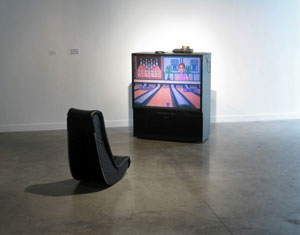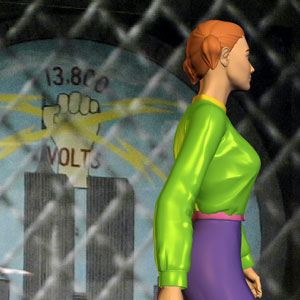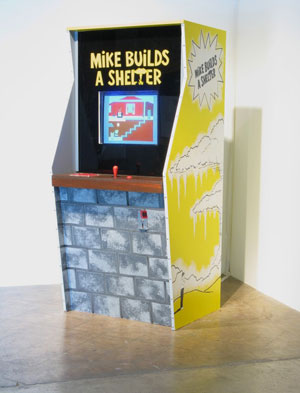
Cory Arcangel...Beat the Champ...(Sega Genesis Championship Bowling: Dana), 2008...installation with hacked Sega Genesis game controller...dimensions variable...Courtesy of the artist and...Team Gallery, New York, NY
Perhaps in response to the never-ending story that is summer in Austin, two venues took on excessive electric bills late this season, promising escapes not only from the heat, but reality itself. Arcade UFO, a self-styled Japanese coin-op, landed on the corner of Speedway and 31st, reversing a recent spiral of Austin arcade disappearances (Einstein’s d. 2008, Dobie Powerplay d. 2006, and Le Fun d. 2005). Meanwhile, Arthouse at the Jones Center invited audiences (the concurrent Austin Video Game Developer’s Conference included) to Reset/Play.
Curated by Marcin Ramocki and tireless Texas new media champion Paul Slocum, Reset/Play codes for a survey of the current intersection of video games and art. The experience is a little more and/or a little less, a smarter though not necessarily sexier breed apart from the quarter popping of Arcade UFO.
Thirteen works on display range from video games to “digital videos with sound” to installations. Labels describe, probably for the first-time, a “commercial video game,” a “self-playing video game,” a “3-D computer animation with sound,” an “interactive sculpture” and a canvas with “conductive paint.” The corresponding artists are largely American but international in scope, and represent a genX adolescence at its most generous—birth-years stretch from 1951 to 1984. With work by heavyweights JODI and Michael Bell-Smith, Slocum and Ramocki affirm their genre history; with back- and forward-looking inclusions such as Michael Smith and Keita Takahashi they show that they are also writing it.
The gaming referents similarly run from classic—1980s Atari Mission Control—to contemporary—World of WarCraft—and nascent—Takahashi’s Katamari Damacy (2004). A spectrum of graphics styles triggers both the nostalgia of pixilation and the future-tech seduction of flat-screen CGI. In a keen curatorial move, the absence of earphones opens a subtle din of bleeps, bloops and electronic commotion. The pop familiarity engages the regular questions of “what am I looking at” and “how is this different (than life)” but, given the nature of the signifiers, with a fresh emphasis on a corollary, “how do I interact with it?”

Kristin Lucas...5-Minute Break, 2001...digital video with sound dimensions variable...4 minutes, 35 seconds...Courtesy of the artist and And/Or Gallery, Dallas, TX
Answering the first, Slocum and Ramocki, both gallery founders and artists, squarely fit the projects on display as capital-A art. Perhaps in a legitimizing move, they do little to challenge Arthouse’s framing context. Amongst expanses of white–—not black—walls, the flat screens, projections and pedestal-bound monitors take on the concentrated presence of painting and sculpture. A lone radioactive green backdrop feels idiosyncratic instead of inspired. Cory Arcangel’s minimalist rec room and the invitation of Takahashi’s PS2 in the building’s window facade go a long way, but not far enough, to disrupt an installation that feels safe, peripheral and, at turns, oddly stagnant, empty and sterile.
It is not surprising then, and perhaps even a little self-fulfilling, that the didactic forces at Arthouse slap “Play Me” signage, in a toxic green worthy of the energy-drink crowd, next to the exhibit’s truly interactive works. In the context of Reset/Play, you have to be told to play, not not to play. The instructions attached to Arcangel’s sporty rocking chair and large-screen TV are an amusing exception: “You may sit, but please do not play.”
Writing in the exhibition pamphlet, Slocum and Ramocki remark that a good electronic game is neither quite video nor game, it “is its own kind of thing, with its own space and time. It involves user (as opposed to ‘viewer’) familiarity.” They go on to map differences between video games as such and artworks based on video games, the latter taking on conceptual and fine art dimensions. One could and should add critical, self-reflective, perverse and poetic to the list.
The most successful works in Reset/Play seem to directly confront this demarcation. They determine both their own time and space and engage viewers as users, if only vicariously. Likewise, they address the video game not just as subject or content, but also as experiential form. In the hands of these artists, video games transform into cultural-critical vehicles.

Michael Smith...Mike Builds a Shelter, 1983...arcade cabinet, video game...74 x 32 x 36 in...Courtesy of the artist and...Dunn and Brown Contemporary, Dallas, TX
Guthrie Lonergan’s RPG Paint (2004), for instance, hacks a Microsoft Paint application. Mouse-clicking a toolbox of icons both familiar—hand, eraser, paint bucket—and unusual— moon, lightning bolt and vortex—promises moments of logic and control, the imposition of narrative gestures on an otherwise chaotic realm of spectral color, shiny medieval paraphernalia and hooded villains. Playing and producing blend into a single act in which one quite literally manifests and fights off visual spectacle.
Cory Arcangel in Beat the Champ (Sega Genesis Championship Bowling: Dana) (2008) and Kristin Lucas in 5-Minute Break (2001) show that getting beyond the “cool” of technology and developing friction doesn’t necessarily require first-hand play. Arcangel’s Dana, the stooge of a modified Sega Genesis controller, repeatedly bowls gutter balls, while Lucas’s female avatar wanders the sub terrain of an office building, actually the World Trade Center, her machinima halting on still images of the interstitial, overlooked and forgotten. In both works, speed and accomplishment and flare are traded for Beckettian circuits, pause, loss and failure.
Hitting a similar note, Michael Smith’s arcade cabinet Mike Builds a Shelter (1983) makes an excruciating effort of climbing and descending a flight of suburban stairs to complete the titular task. The futility of Mike’s scenario in full view of the nuclear “big one” as represented outside his window and on his television is actually hardwired into the game play (I donated $1.50 to Arthouse to learn this). Smith, along with Arcangel and Lucas, present video games not only as simulations of goal-oriented activities. Screen based phenomenon, they offer mirrors to complex contemporary feelings, including boredom, estrangement and anxiety.
The challenge that electronic media present not an escape from reality, but a site in which the exchanges of everyday life are increasingly mediated, takes an ugly turn in Eddo Stern’s Best…Flame War…Ever… (King of Bards vs. Squire Rex, June 2004) (2007). Two masks modeled from an amalgamation of Everquest dragons, wizards and the like re-enact an online message-board “discussion” between two gamers of the MMORPG (massively multiplayer online role-playing game). The meta-discourse quickly spirals into testosterone-driven posturing, invocations of patriotism, threats of physical violence and eventually shamed community reconciliation.

Eddo Stern...Level sounds like Devil...(BabyInChrist vs. His Father, May 2006), 2007...3D computer animation with sound...dimensions variable...10 minutes...Courtesy of the artist
Given the boom development of vast online gaming networks and the rising acceptance of video games as spectator sports, the theme of interconnectivity is surprisingly underrepresented in Reset/Play. Alexander Galloway’s How To Play World of WarCraft (2005) installation journals the keystrokes, mouse-clicks and “kills” of a marathon networked gaming session. However, as an event itself, it stays at the level of representation. Attempting to match the timecode of the videos, cropped to hand views, with the detailed flow charts only marginally allows one to penetrate the vicissitudes of the experience. (In another suggestive but unresolved quirk of the exhibition installation, occasionally a laptop, cracked like a glowing A-frame, leads one away from the actual work it is playing, and curiously into the floor space of another work).
The presentation of new media and video game art in real-world public, if not simply physical, quarters remains an open question. Virtual media increasingly maps new social space, but is its material location limited to personal parcels? Reset/Play importantly attempts to situate new media works in shared, tangible space. Although it doesn’t always win, relying perhaps too heavily on art-historical tropes, the exhibition initiates necessary speculation on the shape of things to come. It is a discussion that may be better answered not by asking, “how do I interact with it,” but simply “how do we interact?”
At UFO Arcade, two opposing rows of seated, large-screened and linked video game consoles dominate the main floor. Their signage features the latest in several long running fighting series: Tekken, Street Fighter, etc. By dropping a dollar coin, you can choose to play the computer or enter “the ring,” a form of pick-up competition amongst the neighboring machines. Playing it safe only lasts so long; tallying victories against the CPU inevitably lands you in the ring as well. Given the cabinet configuration, you may never actually rub elbows, let alone meet, your human counterpart. Even out at the arcade, we may only be known by screens.
Reset/Play
Arthouse
September 6 to November 2, 2008
Artist and writer Kurt Mueller is currently a critical studies resident at the Core program. He once spent inordinate hours playing Ikari Warriors, Space Quest and Civilization.




